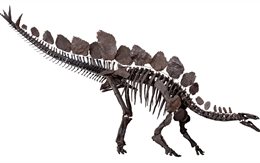Stegosaurs are dinosaurs characterised by plates and spikes extending down their backs. Despite being one of the most iconic dinosaurs, their fossils are rare, and much remains unknown about their palaeobiology.
In 2016 the Natural History Museum acquired a new stegosaurian dinosaur from the Middle Jurassic (~168 million years ago [mya]) of Morocco. The material is extremely significant because (i) stegosaurs are known predominantly from the Upper Jurassic (~150 mya); this material represents one of the oldest records of the group, and (ii) stegosaurs were previously unknown from north Africa; this material represents an entirely new biogeographic data point. The Moroccan stegosaur may prove extremely important for understanding the evolution and subsequent radiation of the herbivorous dinosaurs.
Dinosaurs were discovered in Morocco in the 1940s, but most lack contextual information about the age of the fossils and environment in which they lived, greatly devaluing their worth for our understanding of dinosaur palaeobiology. Almost uniquely, the location where the new stegosaur was found is known.
During this project, my collaborators from the Natural History Museum and I will visit the site in Morocco and collect contextual information regarding the age, and depositional environments of the rocks. This will allow accurate dating of the specimen, and reveal much about its life history and ecology. During this fieldwork, we will characterise the potential of the rocks for preserving further, equally important palaeontological material.

The mounted skeleton of the stegosaurian dinosaur Stegosaurus stenops from the Upper Jurassic of the western USA.
Picture: The Natural History Museum; from Maidment et al. 2015. PLoS One 10 (10): e0138352]